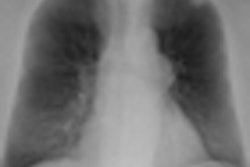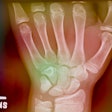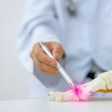A new study published in this month's issue of Journal of Children's Orthopaedics indicates that breech babies at risk of hip dysplasia might benefit from an extra imaging exam beyond what's recommended by current clinical guidelines.
Breech babies have a high risk of developing hip dysplasia and should have a screening ultrasound exam after 2 weeks of age, according to appropriateness criteria published in August 2009 by the American College of Radiology (ACR) of Reston, VA.
However, pediatric orthopedic specialists at Rady Children's Hospital in San Diego recommend that breech infants with normal clinical and screening ultrasound exams performed at 6 weeks of age also have another clinical and radiology exam to identify hip dysplasia when they are between 4 and 6 months old.
Over a five-year period, almost 30% of breech babies with normal hips at 6 weeks of age were diagnosed with hip dysplasia and required treatment when they had six-month checkups, according to a study published in the February issue of the Journal of Children's Orthopaedics (2010, Vol. 4:1, pp. 3-8).
After radiologists began noticing cases of hip dysplasia on x-rays of young infants born breech, the hospital recommended that infants who had a normal screening ultrasound return for an x-ray exam at 4 and 6 months of age. To identify the actual incidence of developmental dysplasia of the hip, and the age at which it was identified in breech infants, a research team led by Dr. Meghan Imrie, then a fellow in the pediatric orthopedics and scoliosis division, reviewed the medical records of 300 breech babies born from 2004 through 2008.
Thirty-four (11.3%) of the infants had clinically unstable hips. Screening ultrasound exams were performed at approximately 6 weeks of age for 266 infants by an experienced sonographer and evaluated using the Harcke dynamic method. Of these, 73 patients (27%) had abnormal results and were subsequently treated.
In all, 193 6-week-old infants were considered normal, with clinically stable hips, full symmetric abduction, and normal ultrasound exams. Of these, 131 had a follow-up radiograph and clinical examination at Rady Children's Hospital, performed at an average 5 months of age. Frog-leg lateral radiographs and anteroposterior pelvic exams were performed.
Thirty-eight patients, or 29% of the 131 infants, were considered to be dysplastic based on clinical and radiographic evaluation and were placed in a Pavlik harness. Sixty-two percent had acetabular indices at least two standard deviations from the age-corrected average, compared with 26% of patients in the group with normal follow-up examinations who were not treated.
The authors commented that they may have been overtreating some infants whose hips would normalize without intervention. They justified this decision by pointing out that the treatment of mild dysplasia with a harness has relatively low morbidity compared to the surgical treatment of an older child with missed or persistent dysplasia.
By Cynthia E. Keen
AuntMinnie.com staff writer
February 15, 2010
Related Reading
ACR issues guidelines on pediatric hip dysplasia, August 11, 2009
US screening advised for newborns at risk for hip dysplasia, July 2, 2009
Copyright © 2010 AuntMinnie.com



















